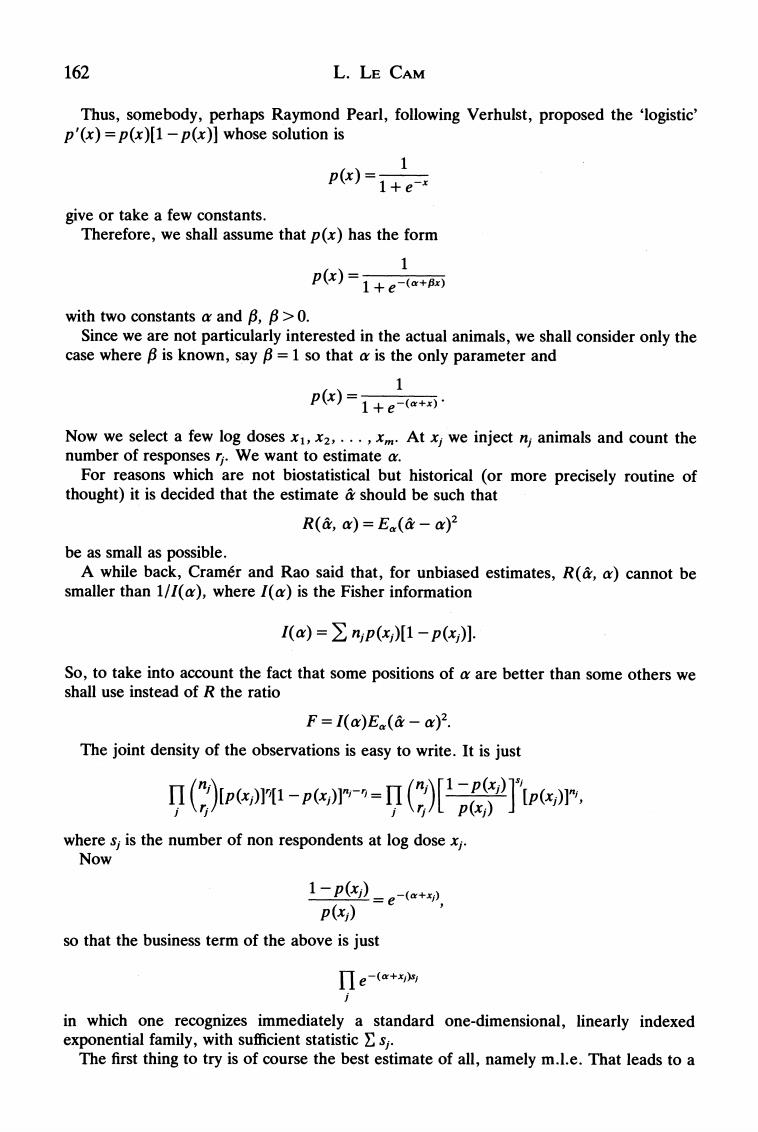正在加载图片...

162 L.LE CAM Thus,somebody,perhaps Raymond Pearl,following Verhulst,proposed the 'logistic' p'(x)=p(x)[1-p(x)]whose solution is p刻1+2 give or take a few constants. Therefore,we shall assume that p(x)has the form 1 p(x)=1+e(a+网 with two constants a and B,B>0. Since we are not particularly interested in the actual animals,we shall consider only the case where B is known,say B=1 so that a is the only parameter and 1 p(四)=1+e(+雨· Now we select a few log doses x1,x2,...,x.At x,we inject n,animals and count the number of responses r.We want to estimate a. For reasons which are not biostatistical but historical (or more precisely routine of thought)it is decided that the estimate a should be such that R(a,a)=Ea(a-a)2 be as small as possible. A while back,Cramer and Rao said that,for unbiased estimates,R(a,a)cannot be smaller than 1/I(a),where I(a)is the Fisher information I(a)=∑n;p(c1-p(小 So,to take into account the fact that some positions of a are better than some others we shall use instead of R the ratio F=I()E.(d-a)2 The joint density of the observations is easy to write.It is just Π(pe-perm-Π(r. where s,is the number of non respondents at log dose xi. Now 1-px2=e-(a+0, p(x) so that the business term of the above is just Πe-(a+两 in which one recognizes immediately a standard one-dimensional,linearly indexed exponential family,with sufficient statistic s;. The first thing to try is of course the best estimate of all,namely m.l.e.That leads to a162 L. LE CAM Thus, somebody, perhaps Raymond Pearl, following Verhulst, proposed the 'logistic' p'(x) =p(x)[l -p(x)] whose solution is p(x) =1 + e-x give or take a few constants. Therefore, we shall assume that p(x) has the form p(x) = 1 + 1e- e-(*a+x) with two constants a and f3, f > 0. Since we are not particularly interested in the actual animals, we shall consider only the case where f is known, say f3 = 1 so that ac is the only parameter and p(x) = 1( 1 + e-('"+X)' Now we select a few log doses x1, x2,.. ., x,. At xj we inject nj animals and count the number of responses rj. We want to estimate a. For reasons which are not biostatistical but historical (or more precisely routine of thought) it is decided that the estimate & should be such that R(&, a)=E,(&- C)2 be as small as possible. A while back, Cramer and Rao said that, for unbiased estimates, R(&, a) cannot be smaller than 1/1(ca), where I(a) is the Fisher information I(a) = njp(xj)[l -p(xj)]. So, to take into account the fact that some positions of a are better than some others we shall use instead of R the ratio F = I(a)E,(& - a)2. The joint density of the observations is easy to write. It is just H (r)[P )] p)] H (r )[ p(xj) where sj is the number of non respondents at log dose xj. Now 1-p(xi) =_(+Xj) p(xj) so that the business term of the above is just Il e-(t+xj)sj j in which one recognizes immediately a standard one-dimensional, linearly indexed exponential family, with sufficient statistic E sj. The first thing to try is of course the best estimate of all, namely m.l.e. That leads to a